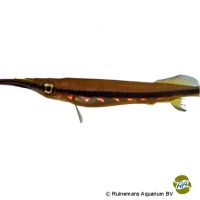Ornate Halfbeak (Hemirhamphodon chrysopunctatus)
| Ornate Halfbeak Hemirhamphodon chrysopunctatus | |
|---|---|
| Name | Ornate Halfbeak |
| Name Lat. | Hemirhamphodon chrysopunctatus |
| Family | Viviparous Halfbeaks |
| Family lat. | Zenarchopteridae |
| Order | Needle Fishes |
| Order lat. | Beloniformes |
| Origin | Borneo |
| Habitat | Forest streams |
| Diet | Carnivore |
| pH | 5.8-7.0 |
| Behavior | ♂ territorial |
| Keeping | Harem |
| Care Level | Experts only |
| Reproduction | Livebearer |
| Breeding | None reported |
| Life Span | N/A |
| Protection | No |
| Metric Units | |
| Size | 9 cm |
| Temperature | 23-28 °C |
| Hardness | 1-5 °dH |
| Aquarium | ~ 150 l |
| US Units | |
| Size | 3.5" |
| Temperature | 73-82 °F |
| Hardness | 18-53 ppm |
| Aquarium | ~ 40 gal |
Distribution and habitat
As early as the 11th century in China, the goldfish was bred out of red-gold color morphs of the silver crucian carp, according to other sources from the gable. Veiltails, goldfish with a squat body shape and split tail fin, have existed in China since the 15th century and are bred in many varieties. The bubble-eyed veiltail has an egg-shaped body without a dorsal fin and comes in several color varieties.
Maintenance
The aquarium should have hardy plants, a decoration of roots and stones, sufficient swimming space and a substrate of round-grained gravel and sand.
No ammonia, ammonium and nitrite should be detectable, the nitrate value should not exceed 100 mg/l. To ensure the water quality and oxygen content, a filter adapted to the aquarium size is required, as well as lighting for the species-appropriate day-night rhythm of the animals
Diet
They are easy to feed. The food supply consists mainly of commercial special dry food for goldfish, such as flakes, sticks or granules with low protein content (below 30%). In addition, they require plant food, such as aquatic plants (Elodea densa, Cabomba caroliniana, Rizzia flutians, etc.) or scalded leaves (spinach, dandelion) or dry food with plant ingredients (spirulina). Occasionally live food such as daphnia, cyclops, tubifex and mosquito larvae should be offered, which is also accepted without problems in frozen form. It is recommended to feed small portions several times a day, which are eaten within a few minutes. Regular and varied feeding promotes health and prevents deficiency symptoms.
Behaviour and compatibility
Veiltails are calm, peaceful and sociable fish that do not exhibit any aggressive or incompatible behaviors. At least 5 veiltails should be kept together.
In principle, only mutually compatible fish species with similar requirements for water conditions and water temperature may be socialized.
Sex dimorphism
The sexes are difficult to distinguish. Males are slightly more slender and have a concave (indented) anal opening
Reproduction and breeding
After a pronounced courtship behavior, up to 1,000 and often even more eggs are laid. The larvae hatch after five days.
Fry must be fed several times a day with special rearing food. In community tanks breeding is hardly possible, because the spawn is easy prey.
Important
Veil tails were bred in China for supervisory ponds and show their special beauty in the view from above. They require warmth and are therefore not suitable for year-round keeping in the garden pond.
The eye bladders of the veiltails are particularly vulnerable to injury. Careful maintenance and appropriate aquarium setup (e.g. no sharp stones, no strong filter current) must be ensured.
The well-being of the fish should be checked regularly. The temperature should be checked daily, the pH-value, hardness and nitrate value at least every 14 days. Regular partial water changes are recommended, even if the pollutant load has not yet reached the upper limit. Sudden changes in water quality should be avoided. Newly introduced fish must be accustomed slowly to the water in the aquarium.
The fish must not be kept in spherical containers.
Further literature can be found in your pet store.
References
Text: petdata; Image: Franz Lowak
Source: BMELV (1998): Tierschutzgutachten - Haltung von Zierfischen (Süßwasser); RIEHL & BAENSCH (2006): Aquarien Atlas Bd. 1, Mergus Verlag; ENGELMANN (2005): Zootierhaltung - Tiere in menschlicher Obhut: Fische, Verlag Harri Deutsch
- Gemäß § 21 Abs. 5 Tierschutzgesetz idgF
